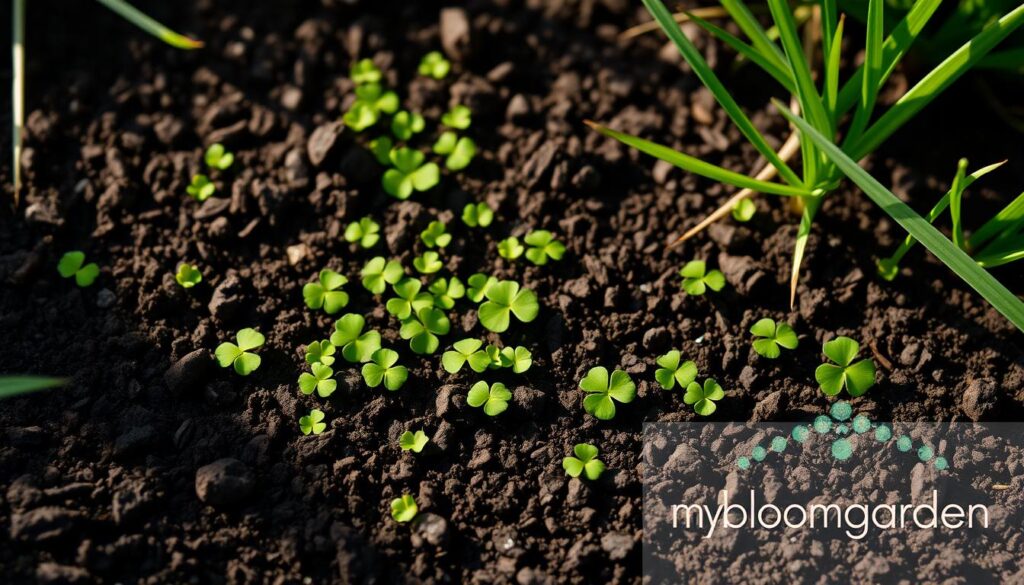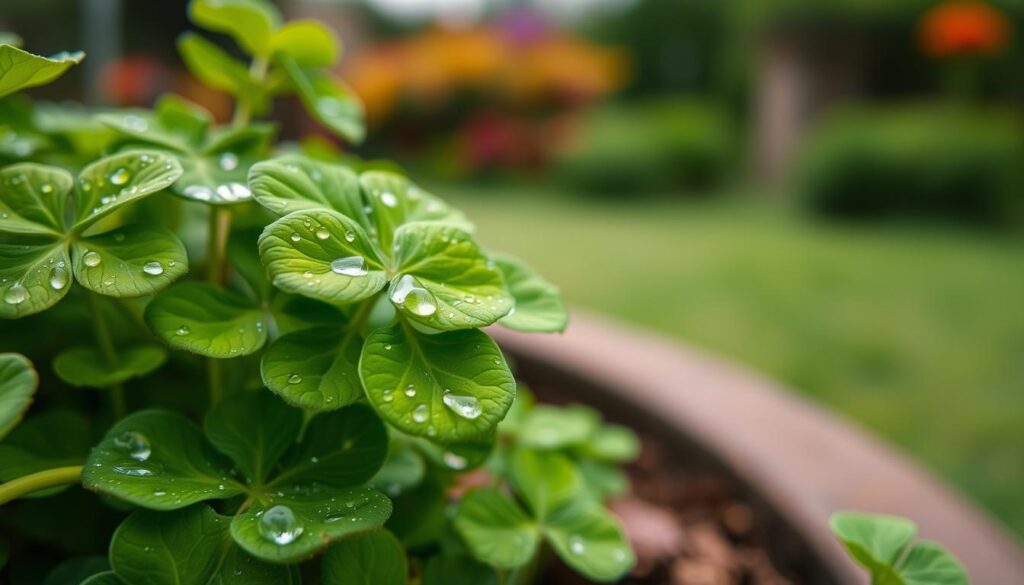Looking at your lawn and dreaming of a lush, green carpet? You might be surprised to find that the answer is not in regular grass. Instead, it’s in the simple clover plant. This plant is not just beautiful but also good for the environment and saves money. Let’s explore how to plant and care for a clover lawn that turns your outdoor area into a peaceful oasis.
Table of Contents
Understanding the Benefits of Clover in Your Lawn
Choosing to plant clover in your lawn has many benefits. It’s good for the environment and can save you money. Clover is a great choice for those who want a beautiful lawn without much work.
Environmental Advantages of Clover Growth
Clover improves soil health, which is a big plus. It fixes nitrogen in the soil, cutting down on the need for chemical fertilizers. This helps other plants grow well and boosts biodiversity in your garden.
Cost-Saving Benefits for Homeowners
Clover uses less water than traditional grass, saving you money on your water bill. It also means you don’t have to mow as often, saving you money in the long run. This makes clover a smart choice for your wallet.
Natural Nitrogen Fixing Properties
Clover’s ability to fix nitrogen in the soil is impressive. It makes the soil richer, reducing the need for harmful chemical fertilizers. This way, you can have a healthy lawn without harming the environment.
“Incorporating clover into your lawn is a smart, sustainable choice that can benefit both your garden and your wallet.”
Best Clover Varieties for Your Lawn
Choosing the right clover variety is crucial for your lawn. Clover types vary in growth, appearance, and soil adaptability. Let’s look at some top clover varieties for your lawn:
- White Clover – A classic choice, white clover grows lush and dense. It thrives in many soils. Its small leaves and white flowers add beauty to any lawn.
- Red Clover – Red clover stands out with its larger leaves and pinkish-purple flowers. It’s great for poor soils or where nitrogen is needed.
- Microclover – Microclover has small leaves and a uniform look. It’s perfect for blending into existing lawns. Plus, it needs less mowing.
When picking clover for your lawn, think about your climate, soil, and preferences. The right clover can make your lawn lush and vibrant. It also needs less care, from plant clover to from seed to spice.
“Clover is a versatile and valuable addition to any lawn, offering a beautiful, low-maintenance solution that can enhance the overall health and appearance of your outdoor space.”
When to Plant Clover: Optimal Timing for Success
Timing is key when planting clover for your lawn or garden. The right season can greatly impact your clover’s growth. We’ll look at the best times for spring and fall planting, and how climate affects these times.
Spring Planting Guidelines
Spring is a great time to plant clover in many areas. The soil is cool and moist, perfect for germination. Plant in early to mid-spring when the soil is at least 60°F (15°C) and frost is gone.
Fall Planting Considerations
Fall is also good for planting clover, especially in mild autumns. The temperatures are moderate, and the soil is moist. But, make sure the clover has time to grow strong before winter.
Climate-Specific Timing
- In warm, subtropical areas, plant clover from late fall to early spring.
- In cooler, northern places, plant in mid-spring to early summer when the soil is warm.
- In hot, dry summers, fall planting is best to get a head start before the heat.
Check your soil’s temperature and moisture to find the best time to plant clover. This ensures a beautiful, lush clover lawn or garden.
How to Plant Clover in Your Existing Lawn
Want to add clover to your lawn? It’s easy and can make your lawn healthier and look better. Just follow these simple steps to add clover to your lawn and enjoy its benefits.
Prepare the Area
First, lightly aerate the soil where you’ll plant the clover. This helps the seeds grow better. You can use a core aerator or a garden fork to make holes in the ground.
Sow the Seeds
- Spread the clover seeds over the area, following the package’s instructions.
- Rake the seeds into the soil, just below the surface.
- Water well until the clover seedlings grow.
Establish a Mixed Lawn
As the clover grows, it will mix with your lawn’s grass. Keep the mowing height balanced to let both thrive. This creates a lush, diverse lawn.
“Integrating clover into your lawn is a simple and effective way to create a more eco-friendly and low-maintenance outdoor space.”
Be patient and keep caring for the clover in your lawn. With a bit of time and effort, you’ll have a stunning, sustainable lawn. It will show off the perks of plant clover.
Soil Preparation and Testing Requirements
Getting your soil ready is key to a successful planting clover experience. Before you start, knowing what your soil needs is crucial. This ensures your lawn will be lush and green.
pH Level Optimization
Clover loves soil that’s slightly acidic to neutral. The best pH range is between 6.0 and 7.0. To find out your soil’s pH, do a soil test. If it’s off, you can fix it with lime or sulfur.
Soil Amendment Techniques
- Add compost or well-rotted manure to boost nutrients and hold water better.
- Aerate the soil to increase oxygen and help roots grow.
- Use a balanced, slow-release fertilizer to feed your clover growth.
Ground Preparation Steps
- Till or cultivate the soil 4-6 inches deep to loosen it up.
- Rake the surface to make it smooth and even.
- Clear out debris like rocks, sticks, and weeds for better seed-to-soil contact.
By preparing and testing your soil well, you’re on your way to a beautiful clover garden. Your lawn will be the talk of the town.
Essential Tools and Materials for Planting
Planting clover in your garden or lawn needs the right tools and materials. Whether you’re experienced or new to growing clover, the right equipment is key. It helps you how to plant clover and get a lush, green carpet.
A quality seed spreader is crucial for planting clover. It spreads the clover seeds evenly, ensuring good coverage and less waste. Also, a sturdy rake is needed to gently mix the seeds into the garden practice soil. This helps the seeds germinate well.
- Seed spreader
- Rake
- Soil amendments (e.g., compost, peat moss)
- Watering can or hose
- Clover seeds
Choosing the right clover seeds is important. Pick a high-quality, certified variety that fits your local climate and soil. Make sure the seed package clearly states the from seed to spice type, like white or red clover.
“Proper preparation and the right tools are the keys to a thriving clover lawn or garden.”
Remember to have soil amendments ready, like compost or peat moss. They help enrich the soil and give your clover plants the nutrients they need. With these tools and materials, you’ll be ready to how to plant clover and create a stunning, easy-to-care-for garden practice that will impress your neighbors.

Seeding Techniques and Coverage Rates
Planting clover in your lawn needs careful attention to how you seed and how much you use. You can either broadcast the seeds or hand-sow them. Making sure the seeds are spread out right is key for the clover to grow well.
Broadcasting Methods
Broadcasting seeds across your lawn is a common and effective way. You can use a rotary spreader or a hand-cranked seed broadcaster. Broadcasting works great for big lawns because it covers a lot of area fast and evenly.
Proper Seed Distribution
- For the best results, aim to use 4-6 pounds of seeds per 1,000 square feet of lawn.
- Make sure to overlap your passes to get an even spread and avoid missing spots.
- After broadcasting, gently rake or roll the lawn to help the seeds touch the soil.
No matter your seeding method, proper seed distribution is crucial. It’s the secret to planting clover and getting a lush, thriving lawn from seed to spice.
“Clover is a game-changer for any lawn, offering a natural, sustainable solution that can transform your outdoor space.”
Maintenance and Care After Planting
Creating a lush plant clover lawn is more than planting. It needs ongoing care to succeed. Here’s how to keep your four leaf clover plant healthy after planting.
Watering and Irrigation
Clover can handle some drought but needs regular water. Water it about 1 inch a week, either from rain or a hose. Adjust how often you water based on the weather.
Mowing Practices
- Keep the grass at 3-4 inches to help roots grow deep and foliage get dense.
- Don’t cut more than a third of the grass at once to avoid stressing the four leaf clover plant.
- Leave the clippings on the lawn to act as natural fertilizer.
Fertilization Needs
Clover fixes its own nitrogen, but a balanced garden practice fertilizer can boost growth. Use it once or twice a year.

“A healthy plant clover lawn needs the right balance of water, mowing, and fertilizer. With proper care, your lawn will stay lush and vibrant for years.”
By following these tips, your four leaf clover plant lawn will flourish. It will become a stunning, easy-to-care-for part of your yard.
Troubleshooting Common Clover Growing Issues
Growing a lush clover lawn needs careful attention and solving any problems that come up. You might face pests, diseases, or uneven growth. Knowing how to fix these issues can keep your garden healthy and vibrant.
Pest Management Strategies
Pests can be a big problem for clover growers. Look for signs like chewed leaves or stunted plants. Use organic pest control, like beneficial insects or natural repellents, first. If needed, eco-friendly pesticides can help protect your clover.
Disease Prevention Tips
Diseases can harm your clover too. Watch for fungal or bacterial signs and act fast. Good drainage, right soil moisture, and disease-resistant varieties can help. If disease strikes, treat it quickly and isolate the area.
Growth Pattern Problems
- Uneven growth can come from bad soil, wrong seeding, or weeds. Aerating, overseeding, and weed control can help even out your clover.
- Slow growth might mean poor soil or bad conditions. Test your soil and fix any nutrient gaps. Make sure your garden meets your clover’s needs.
- Too much spreading can outcompete other plants. Regular mowing and selective removal can manage clover growth.
By tackling these common issues with proactive steps and quick fixes, you can have a beautiful, healthy clover lawn. It will make your outdoor space even more stunning.
Conclusion
Planting a clover lawn offers many benefits for your property and the environment. Clover fixes nitrogen naturally, saving you money on fertilizers. It’s a smart, green choice for your landscape.
With the tips from this article, you can grow a healthy, green lawn. Start by planting clover and enjoy a sustainable lawn. Make sure to care for it well to keep it thriving.
Choosing clover is good for your lawn and the planet. It’s a step towards a greener, easier-to-care-for yard. Begin your journey to a beautiful, eco-friendly lawn today.

